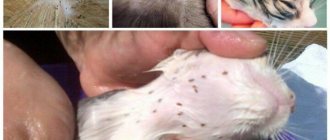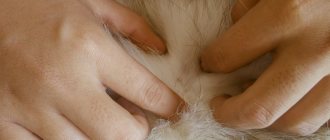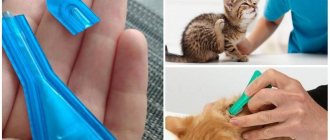Symptoms by stage of infection
To determine the presence of parasites on a cat’s body, you need to carefully monitor the animal’s behavior. Depending on the severity of the infection, symptoms will vary slightly.
First stage
It is not easy to determine the presence of fleas at the very beginning. There are still few parasites; some exist only in the form of eggs laid by an adult. They do not bite yet, and the behavior of the pet itself is unlikely to help notice the problem.
Symptoms: At this stage, your cat or tom may scratch occasionally.
Second stage
The egg turns into an individual that can cause discomfort to the animal. Fleas reproduce quite quickly in favorable conditions, such as moderate humidity, room temperature (about 25 degrees) and good nutrition for the pet. If at the first stage the owner still missed the appearance of unpleasant parasites, then at the second stage it is much easier to detect fleas.
Symptoms: the cat will constantly scratch itself, small wounds and scratches are possible on the skin.
Progressive disease
If until this moment no one paid attention to the ectoparasites attacking the cat, then it will be difficult to remove them. Fleas not only cause physical discomfort, but also have a negative psychological effect on the animal.
Symptoms: the mood becomes increasingly dull, depressed, the animal is completely inactive. The appetite decreases, causing the cat to rapidly lose weight. A noticeable sign of a progressive disease is hair falling out, and it falls off in clumps. If at the previous stage the animal is irritated, then at this moment it is simply tired and, most likely, moves very little.
Causes of the disease
It is wrong to think that only a cat on its own can pick up parasites. On the street, through contact with other animals, it is easiest to become infected, but this is not the only way.
Fleas can settle on an animal’s body in the following cases:
- Upon contact with an infected animal. Communication with such cats and dogs can happen not only on the street, but also in the entrance.
- Fleas sometimes remain on fur that has fallen from an infected animal, without direct contact with it.
- Ectoparasites can quite accidentally end up on the clothes or shoes of a person who is going home to their pet, and there the harmful insects can easily find their prey.
- Fleas love warm and moderately damp places, so sometimes adult fleas lay eggs not on the animal’s fur, but, for example, in the basement. When insects hatch, they immediately begin to look for a way to feed themselves, and at this moment they may stumble upon an animal accidentally passing by.
It is important to remember that if a pet sits at home, it is not 100% protected from infection by parasites, and therefore you should always pay attention to the cat’s well-being, its behavior, appearance and appetite. It costs nothing to occasionally check an animal's fur, but such an inspection can save it from suffering.
Determining the presence of fleas in a cat
The first sign of a cat being infected is a change in its behavior: it begins to itch a lot and also chew its fur in an attempt to reduce the discomfort from insect bites. In addition, the animal may complain to the owner, meowing and moving restlessly around the apartment. Having discovered such changes, it is necessary to immediately subject it to a thorough inspection.
The flea is a dark-colored insect (brown or black), 2-3 mm in size. They don't have wings, but they are very jumpy. If an animal is infected with these ectoparasites, then they can be found not only on its fur, but also on its sleeping place. In the future, they can be anywhere: under baseboards, in carpets, clothes, furniture. They also bite humans.
To examine your pet, you will need a fine-toothed comb. It is necessary to carefully comb the cat's coat and inspect its skin, parting the fur. If there are few parasites, then they are not easy to detect. But traces of their presence are immediately visible: there will be black dots left by fleas on the animal’s skin.
After thoroughly combing the cat, you need to shake the comb over a white sheet of paper. This will allow you to see the flea feces in the form of black dots remaining on the teeth of the comb.
If the cat has been infected for some time and there are a lot of parasites, then you can see them right away. In some cases (usually in stray cats), flea colonies reach such numbers that the fur literally moves from their movements.
Catching fleas is almost useless. The insect's body has a hard chitinous cover, and its shape does not allow it to effectively destroy the flea. This is generally not an option for getting rid of parasites, since larvae remain on the body, from which new individuals will soon hatch.
Examination of the animal
A simple way to detect ectoparasites involves the following steps:
- Take a comb with fine teeth.
- Go over the cat's fur over a sheet of white paper, trying to work the comb from the very base.
- If there are dark small crumbs left on the paper, then it is possible that these are flea excrement.
- To finally confirm the presence or absence of parasites, drop water on the brown crumbs. If it is flea discharge, it will turn brown from the water.
Just because you don't see insects doesn't mean they aren't there. Your cat's skin should be checked for bites, eggs and parasite secretions. Most often, fleas attack areas under the tail and on the stomach. In small kittens they often climb right onto their faces.
The danger of fleas for pets
In addition to the obvious inconveniences that fleas bring to an animal, there are a number of additional dangers:
- When bitten, the integrity of the skin is compromised and infection can enter the wounds;
- substances that a flea injects into the animal’s blood during a bite can cause an allergic reaction.
- fleas carry fungal and viral infections and can infect an animal with helminths;
- constant frequent bites cause anemia;
- the itching caused by bites affects the mental state of the animal - it becomes nervous and hysterical.
Flea infestation is especially dangerous for small kittens. Blood-sucking insects cause anemia in them, leading to complete exhaustion and death. It is important to detect a disease in a kitten in time in order to help it. To do this, you should examine not only the animal, but also its sleeping place. To understand where a domestic cat gets fleas , it’s a good idea to look under the carpeting, behind sofas and other upholstered furniture. Fleas are dangerous because they are excellent at hiding and waiting for the right moment to attack.
Facilities
To combat ectoparasites, it is worth turning to special drugs. Depending on the age of the animal and the stage of development of the disease, the remedies will vary. Let's look at the basic and effective ways of how and with what you can cure a cat from fleas.
Shampoo
This remedy is suitable for the early stages of infection. However, we must remember that you can use shampoos no more than once every 10-14 days, otherwise washing may have a negative effect on the cat’s skin.
Among the advantages, it is worth noting the low price for a drug that can be used more than once. And also effectiveness - if the cat’s fleas have not yet taken root, then just a couple of treatments will be enough to remove the parasites completely.
The most effective shampoos:
- Phytoelite;
- Celandine;
- Mr. Kiss;
- Leopard;
- BioVax;
- Rolf Club.
Injections and tablets
Invasive procedures, or simply injections, should be used in later stages of the disease, the same can be said about tablets. The advantages of such drugs are a quick and high-quality effect if the disease progresses. The downside is that not all cats can be forced to take the pill, and the tricks of the owners cannot always deceive the pet.
Injections must be selected very carefully, since if you use a drug for a kitten that is suitable for an adult animal, the baby’s skin can be seriously damaged.
Among these means of control, attention should be paid to:
- Comfortis;
- Invermectin;
- Eprimek;
- Lufenuron.
Drops
They can be used both as prophylactic agents (usually they are used for older kittens) and as a means of combating an already manifested disease. Advantages: fast action.
If you are looking for a quick and easy way to cure your cat for fleas, after applying the drops, literally within 24 hours, there will be no trace of parasites left. However, among the disadvantages it is noted that adult cats sometimes simply lick drops from the skin.
Effective means:
- Stronghold;
- Dana;
- Frontline.
Collars
They are very convenient to use, as they practically do not cause discomfort to the animal. Collars are available for different periods of wearing.
Typically, such products are used as preventatives for cats that spend time outside. If the owner forgets to change the collar on time or simply the product is of poor quality, then the animal may be at risk. You can read more about flea collars for cats here.
Sprays
Sprays are considered one of the most effective means, you just have to remember that some of them are quite toxic, and therefore cannot be used on kittens. There are also contraindications for pregnant and lactating cats.
Important! When spraying, protect the animal's nose and mouth.
Sprays to combat parasites:
- Leopard;
- Harts;
- Frontline.
Powders
Such means are the safest. They are suitable for pregnant and lactating animals and small kittens, but have almost no effect when treating representatives of long-haired breeds.
The powders are simply rubbed into the animal's skin. Hearts can be considered a good option for such a means.
Why are they dangerous?
The consequences of flea infestation in cats appear quite quickly. The presence of parasites negatively affects the pet’s appearance, emotional state, and health:
- severe itching appears;
- the condition of the skin and fur worsens (the cat scratches the bites, wounds appear on the skin, and the hair falls out in places);
- due to flea saliva entering the blood, allergic dermatitis develops;
- helminthiasis;
- infectious diseases appear;
- cats can develop anemia from numerous flea bites;
- Due to constant discomfort, appetite deteriorates, sleep deteriorates, behavior changes - the pet is restless and lethargic.
Fleas do not live on people, but they can attack (if there is no other victim nearby); for the cat owner, it is not so much the insect bites themselves that are dangerous, but their consequences:
- skin irritation, itching, dermatitis;
- allergy;
- worms (in case of accidental ingestion of a flea).
In addition, parasites transmit pathogens of serious diseases, such as anthrax, hepatitis, typhoid and plague.
For kittens, pregnant cats and lactation
Toxic drugs should not be used for these categories of animals. It is better to use the following methods of struggle:
- bathing with shampoo;
- mechanical combing;
- rubbing in powders and powders;
- wearing anti-flea bio-collars.
If the kitten is not yet a month old, none of this is suitable, since all collars are approved for animals from 2-3 months, and bathing can lead to a cold. Usually, domestic babies do not have problems with parasites, since the mother cat keeps an eye on it.
But if a kitten grows up separately from its mother, and fleas attack it, you can go to extreme measures and bathe it. It is better to do this in a bath without soaping (shampoo is recommended for use from 5 weeks of age).
Advice! Do not wet the kitten's face, but immediately after the bath, thoroughly wipe the fur and comb out fleas.










